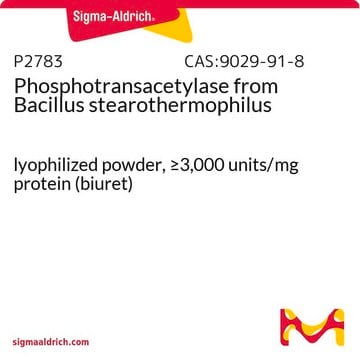MABS1352
Anti-N3-Phosphohistidine (3-pHis) Antibody, clone SC56-2
clone SC56-2, from rabbit
Sinônimo(s):
N3-Phosphohistidine
About This Item
Produtos recomendados
fonte biológica
rabbit
Nível de qualidade
forma do anticorpo
purified antibody
tipo de produto de anticorpo
primary antibodies
clone
SC56-2, monoclonal
reatividade de espécies
human, E. coli
reatividade da espécie (prevista por homologia)
all
técnica(s)
dot blot: suitable
western blot: suitable
Isotipo
IgG
Condições de expedição
wet ice
modificação pós-traducional do alvo
phosphorylation (N3-pHis)
Descrição geral
Especificidade
Aplicação
Western Blotting Analysis: Clone SC56-2 hybridoma culture supernatant was employed for Western blotting analysis of heat-sensitive histidine N3-phosphorylation (3-pHis) of exogenously expressed human PGAM GST fusion protein in lysates from transformed E. coli (Fuhs, S.R., et al. (2015). Cell. 162(1):198-210).
Note: DO NOT HEAT SAMPLES prior to phosphohistidine detection. Histidine phosphorylation is heat and acid labile. To generate negative control for specificity test, an aliquot of sample can be heated at 95ºC for 10-15 minutes to reverse histidine phosphorylation. Alternatively, an aliquot of sample can be incubated under acidified pH at 37ºC for 15 minutes to reduce histidine phosphorylation. Acidify each 100 µL sample with 25 µL of 1 M HCl before the incubation, then neutralize with 25 µL of 1 M NaOH prior to phosphohistidine detection.
Qualidade
Western Blotting Analysis: 0.52 µg/mL of this antibody detected recombinant human phosphoglycerate mutase (PGAM) with N3-phosphohistidine (3-pHis) in a 5 µg aliquot of PGAM-catalyzed 2,3-diphosphoglycerate (2,3-DPG) degradation reaction.
Descrição-alvo
forma física
Outras notas
Not finding the right product?
Try our Ferramenta de seleção de produtos.
recomendado
Código de classe de armazenamento
12 - Non Combustible Liquids
Classe de risco de água (WGK)
WGK 1
Ponto de fulgor (°F)
Not applicable
Ponto de fulgor (°C)
Not applicable
Certificados de análise (COA)
Busque Certificados de análise (COA) digitando o Número do Lote do produto. Os números de lote e remessa podem ser encontrados no rótulo de um produto após a palavra “Lot” ou “Batch”.
Já possui este produto?
Encontre a documentação dos produtos que você adquiriu recentemente na biblioteca de documentos.
Nossa equipe de cientistas tem experiência em todas as áreas de pesquisa, incluindo Life Sciences, ciência de materiais, síntese química, cromatografia, química analítica e muitas outras.
Entre em contato com a assistência técnica







